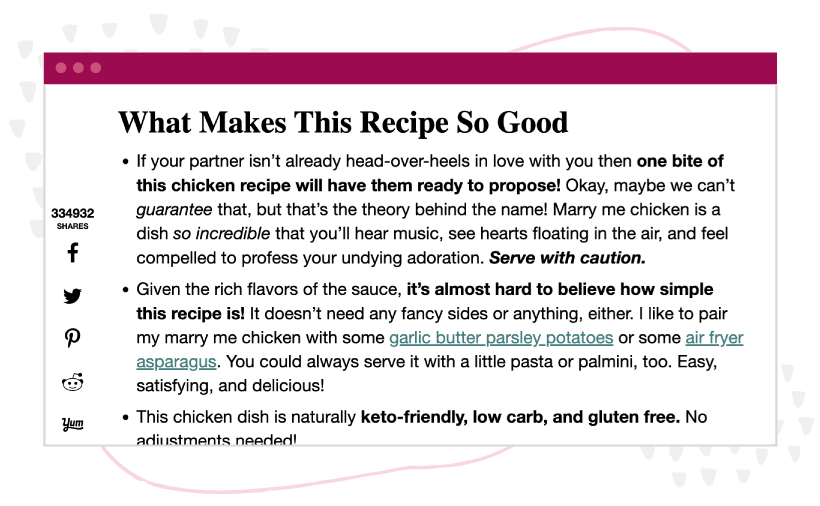You’ve probably come across fluff in writing in your travels around the internet. Maybe you were reading an article or blog post to have a particular question answered, and you found yourself scrolling through long sentences without value to get to the answer.
These wordy sentences could be fluff. We will help you better identify the difference between meaningful and filler content as your freelance writers create content for your brand’s audience.

What is fluff in an article?
Fluff in an article can take on different forms, from embedded or uploaded media to extra features or video elements that don’t add value to the content but are added to lengthen an article.
Fluff in writing, more specifically, refers to unnecessary information or additional words that are crammed in and are obviously added to bolster the word count of a piece of content but bring little to no value.

Why should you avoid fluff in website ad copy?
While you may think fluff writing is relatively harmless, it can do some potentially damaging things to your audience and your brand’s repetition.
Let’s consider a few:
- Your audience could become bored (and bounce rate could increase): If a reader thinks they clicked into your content to get straight, to-the-point information, reading through extra words could bore them and make them exit the article, increasing your bounce rate.
- Your engagement could suffer: Let’s say you plan to invite your audience to comment or engage with your content toward the end of an article. Fluff writing may prohibit your readers from reaching the end or being able or interested in engaging.
- Your clickthroughs could suffer: The more you drive readers away from your content, the fewer conversions you can realize because, ultimately, there is less meaningful traffic on your site. You want a reader to stay, engage, and later, return.
- Your reputation can become tarnished: Depending on your business, fluff writing could become more casual and less serious, damaging your efforts to establish your brand in your industry’s community. You’ll want to avoid fluff writing to show your audience you are serious about the work you do.
Fluff writing turns readers off because it wastes their time and can even turn them away from your brand, which is contrary to the reason you are wanting written content on your brand’s site, to begin with. But fluff writing does not just turn away readers; it also turns away search engines.
Long-form content is king when it comes to ranking high in search engine result pages (SERPs), according to Backlinko, but only when it is the result of “comprehensive content,” or content that is most relevant to the topic your article is covering.
While sites that are able to keep readers engaged for a longer time on-site rank higher in Google, quality of content, as determined by Content Score, can make a difference in ranking.
Leaving fluff writing out of your content isn’t the only thing that affects your Content Score, but it can impact how high your content scores are for helping your site become an authoritative voice amongst your peers.
Are you wondering if you can score your content yourself? You can, and you can even use AI to help.
You should optimize your existing content after seeing your score.

How to avoid fluff in writing
Avoiding fluff in writing could be as simple as refining the tone and voice your content is written in.
Watch your tone
Make sure the content is written in an authoritative tone with action verbs and affirmations. Don’t wish-wash with words that imply to your audience you are unsure about the topic you’re writing about. You’ll want to be careful not to write exactly how you would speak.
This may seem silly, but fluff words often pour out of our mouths when people are naturally conversing.
Think of crutch words, for example. “Um,” and “uh” and “like.” Many people habitually insert these words into verbal sentences as a crutch for a lack of confidence over speaking to the audience. The point is to serve your reader exactly what they want when they come to your article.
Avoid writing as you speak
You’ll also want to limit adverbs and adjectives (remember, this is business content) and avoid using jargon, cliches, and common idioms (ex. “cut and dry” or “soup to nuts”).
While analogies can be compelling and useful in helping an audience comprehend information in an in-person setting like a presentation or meeting, in writing, unless the analogy is concise, the added words could be perceived as filler text.
Format is key in this: if you are bulleting out examples in your content, as long as they are meaningful, you are sharing important information in short form without using filler text.
Stay on topic
The best way to avoid fluff in writing is to ensure your writer stays on topic and avoids unnecessary details. If the added words feel forced or like they add no value, they should not be included in the content.
Avoid redundancy
Also make sure the content lacks redundancy and that common themes or words are not repeated several times throughout the article when the point is just as effective mentioned once.
Keep a close eye on word count
While there is no golden rule for how long a piece of content should be, your audience will see through wordy sentences and will believe you are just trying to showcase as long of an article as possible.
These tips for avoiding fluff are helpful in the content creation process, but the editing portion of the process can be critical to eliminating fluff most of all. Whether you are editing a piece or an editor is looking it over, encourage them to read the content aloud.
Are there wordy portions that can be trimmed? Do sentences tend to run too long? Those are the easiest to cut from the content to avoid fluff. Ideally, a piece should undergo several rounds of editing for accuracy and to ensure filler is not being used.

What is an example of fluff?
There are probably no better examples of fluff in writing than the recipes you’ve likely come across scrolling Pinterest, looking for something to make for dinner. Take this recipe for “Marry Me Chicken” from 40aprons.com, for example.

While the narrative for what makes this recipe so delicious is entertaining, by the time you’ve seen the mouthwatering photo of the chicken on Pinterest and clicked, what you really want to know is how to create the dish yourself.
This recipe is not unique, but recipe sites often share filler writing leading up to a recipe’s ingredients and instructions to entice the reader to scroll longer. This does lead to more page views but is also often seen as an annoyance.
Let’s workshop a few sentences to see how you can eliminate fluff easily:
- Fluff: You know, you may want to consider using a headline evaluation tool to help you craft an extra effective headline to engage your audience.
- No fluff: Using a headline evaluation tool will assist in creating an engaging headline for your audience.
See the difference? Here’s another one:
- Fluff: When you’re thinking about optimizing your article for SEO, you can optimize by using keywords in the intro, body, and conclusion of your article.
- No fluff: You can optimize your article for SEO by including keywords throughout the content.
Fluff-free writing is engaging and concise, like this example:
- Fluff: Putting media (like photos, videos, audio, GIFs) inside your article with embedded code will keep your audience interested as they read through large paragraphs of text.
- No fluff: Embed media (photos, video) in your content to keep your audience engaged.
Don’t let fluff drive your audience away. Invest in high-quality content that is informative, entertaining, and valuable. You’ll help establish your brand as a thought leader in your industry, build trust with your audience, and drive more conversions. Talk to a content specialist at ClearVoice to learn more.



